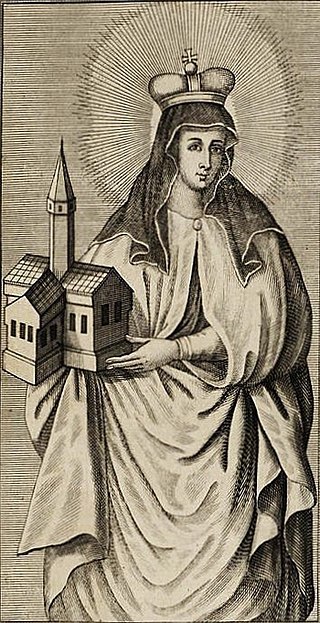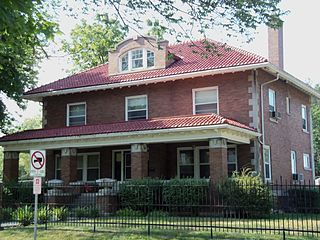
A convent is a community of monks, nuns, friars or religious sisters. Alternatively, convent means the building used by the community. The word is particularly used in the Catholic Church, Lutheran churches, and the Anglican Communion.

The Poor Clares, officially the Order of Saint Clare, originally referred to as the Order of Poor Ladies, and also known as the Clarisses or Clarissines, the Minoresses, the Franciscan Clarist Order, and the Second Order of Saint Francis, are members of an enclosed order of nuns in the Roman Catholic Church. The Poor Clares were the second Franciscan branch of the order to be established. Founded by Clare of Assisi and Francis of Assisi on Palm Sunday in the year 1212, they were organized after the Order of Friars Minor, and before the Third Order. As of 2011, there were over 20,000 Poor Clare nuns in over 75 countries throughout the world. They follow several different observances and are organized into federations.

Timothy Clement Smyth was an Irish born 19th century bishop of the Catholic Church in the United States. He served as the second bishop of the Diocese of Dubuque following the death of Mathias Loras.

Anne of Bohemia, a member of the Přemyslid dynasty, was Duchess of Silesia and High Duchess of Poland from 1238 to 1241, by her marriage to the Piast ruler Henry II the Pious. She was celebrated by the community of Franciscan nuns at St Clara of Prague Abbey in Wrocław as their founder and patron.

Ulrich A. Hauber was a Catholic priest from the United States, who served as the fifth president of St. Ambrose College in Davenport, Iowa from 1926 to 1930.
The Byzantine Discalced Carmelites are communities of Discalced Carmelites that operate in several Eastern Catholic Churches, namely the Bulgarian Byzantine Catholic Church, the Melkite Greek Catholic Church, the Ruthenian Greek Catholic Church, the Ordinariate for Eastern Catholics in France and the Romanian Greek Catholic Church.

James Joseph Davis was an Irish-born prelate of the Roman Catholic Church. He served as the third bishop of the Diocese of Davenport in Iowa from 1906 to until his death in 1926.

Maurice John Dingman was an American bishop of the Catholic Church. He served as Bishop of Des Moines from 1968 to 1986.

The F. H. Miller House is a historic building located in the central part of Davenport, Iowa, United States. The house served as the official residence for two of Davenport's Catholic bishops and as a bed and breakfast. In 2008, the building then housed the Office of Advancement and Alumni Relations for St. Ambrose University, and was called the St. Ambrose Alumni House. In November of 2023, it was purchased privately from the university and is now The Hilltop Inn of Davenport. The property is currently being restored and preserved as best as possible to many of its original styles and furnishings. The Hilltop Inn of Davenport has recently began business and is operating as a boutique hotel and event rental center for various gatherings. It has been listed on the National Register of Historic Places since 1983.

Sclerder Abbey is a former Carmelite monastery in Cornwall, England, UK, located between Looe and Polperro, which accommodates a Roman Catholic Community with an ecumenical vocation, which grew out of a prayer group in Lyon, France, in 1973. It currently has around 2000 members in over 30 countries.
St Mawgan Monastery was a monastery at St Mawgan in Cornwall, UK, originally of Celtic monks and after the Norman Conquest of Cluniac monks.

The Arthur Ebeling House is a historic building located on the west side of Davenport, Iowa, United States. The Colonial Revival house was designed by its original owner, Arthur Ebeling. It was built from 1912 to 1913 and it was listed on the National Register of Historic Places in 1984.
When referring to Roman Catholic religious orders, the term Second Order refers to those communities of contemplative cloistered nuns which are a part of the religious orders that developed in the Middle Ages.
The Colettine Poor Clares are a reform branch of the Order of St. Clare, founded by Clare of Assisi in Italy in 1211. They follow the interpretation of the Rule of St. Clare established by Saint Colette in 1410, originally a French hermit and member of the Third Order of St. Francis.
Former religious orders in the churches of the Anglican Communion are those communities of monks, nuns, friars, or sisters, having a common life and rule under vows, whose work has ended and whose community has been disbanded. In a very few cases this is due to the termination of the work for which the community was established, but in most cases it is due to amalgamation or the death of the final remaining member of the community.

The Monastery of The Holy Spirit, known locally as Kirk Edge Convent is a Carmelite monastery for nuns. It is situated on Kirk Edge Road between the villages of Worrall and High Bradfield within the boundaries of the City of Sheffield, England. It is one of 18 carmels in the United Kingdom. The building stands just within the Peak District at a height of 340 metres and has extensive views of the surrounding area.

The St. Joseph's Church Complex is a collection of historic buildings located in Fort Madison, Iowa, United States. At one time the complex housed a Catholic parish in the Diocese of Davenport. St. Joseph and St. Mary of the Assumption parishes merged in the 1990s to form Saints Mary and Joseph Parish. In 2007 when that parish merged with Sacred Heart on the west side to form Holy Family Parish, St. Joseph's Church was closed. The former church, chapel, rectory, convent, and school were included as contributing properties in the Park-to-Park Residential Historic District that was listed on the National Register of Historic Places in 2014.

Frances Dickinson or Clare Joseph of the Heart of Jesus was a British prioress at Port Tobacco Carmel, Maryland (1755–1830).





















